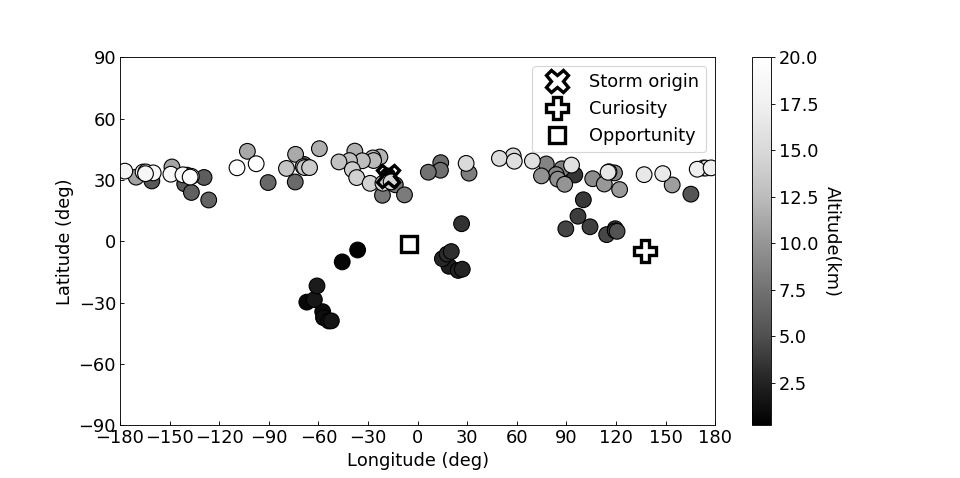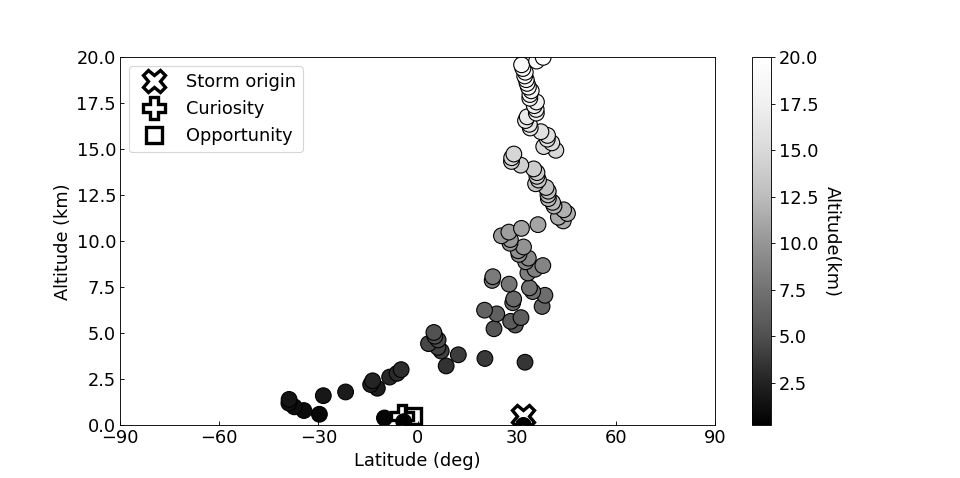Modelling trajectories of wind-blown particles in the Martian atmosphere
- 1Finnish Meteorological Institute, Helsinki, Finland (mark.paton@fmi.fi)
- 2University of Helsinki, Finland
Abstract
Martian dust storms can obscure the lower reaches of the atmosphere from orbiting spacecraft and at the same time obscure the upper atmosphere from landed spacecraft. Inferring the paths of wind-blown particles and their spatial distributions in the atmosphere may help understand the role of the winds in distributing the dust in the atmosphere and on the surface. We describe a simple but useful transport model that calculates the paths of multiple particles using wind data imported from a Mars climate model. We plan to use our model to help understand the role of the winds in the transport of dust around Mars and how the vertical distribution of dust above a landing site may change over time during a dust storm, e.g. to help with our column modelling work.
Background
Two great dust storms of a planetary scale occurred during the first year of the Viking lander missions [1] one starting at Ls=205° (1977a) and the other at Ls=275° (1977b). They are both thought to have originated somewhere in Thaumasia Fossae and Solis Planum in the southern hemisphere about 2000 km southwest of Valles Marineris. The 2018 global dust storm started unusually for a planet-wide dust storm in Acidalia Planitia in the northern hemisphere [2] and started early in the dust storm season at Ls=185°. The dust from this storm is thought to have reached the Curiosity site about Ls=192°.
Method
We use global wind fields from the Mars Climate Database to trace the path of virtual dust particles using a simple transport model based on [3]. The global wind fields are imported into our transport model up to an altitude of 20 km and we interpolate vertically between these fields. In this study we initialise the model by placing 100 particles at altitudes ranging from 200 m to 20000 m at the coordinates of the dust storm origin. The particles are added to the atmosphere at midnight of the first sol and then travel with the winds, i.e. they act like tracers. The vertical velocity of the particles are set to zero in the current version of the transport model.
Results
Figure 1 shows a simulation for the 2018 global dust storm using MCD wind fields. These results indicate the distance a particle would travel after 10 sols given the horizontal wind speeds and directions given in the MCD for an average solar climate. The general trend of the transport of the particles in figures 1 and 2 is that the lower winds transport particles to the south and the upper winds keep particles in a narrow east-west band.

Figure 1 : Particle end points after 10 sols (Ls=185°).

Figure 2 : Vertical profile of the figure 1 particles.
Summary
A simple transport model was used in conjunction with wind fields from the Mars Climate Database to explore dust transport on Mars. It was found that the winds below 10 km could transport dust to the vicinity of Curiosity within 10-15 sols from the start of the 2018 dust storm which is consistent with observations.
The evolution of the 1977A dusts storm was also modelled. As the origin and evolution of the storm is less well known [1] we tried various longitudes and latitudes within the regions of Thaumasia Fossae and Solis Planum. The model inidcates the dust arrived at the Viking lander 1 site at a higher altitude than indicated for Curiosity in figure 2.
The next steps will be to incorperate a vertical velocity component to the particle motion that will involve using MCD vertical velocity fields and the correct physics for modelling the particle's motion in a fluid. The transport model will then be better suited for comparisons with observations at different lander locations and more useful for our analyses of lander meteorological observations using the column model. The transport model could also be useful for understanding the transport of water vapour in the Martian atmosphere.
References
[1] Zurek, Z.W.: Martian great dust storms: An update, Icarus, 50, 288-310, 1982.
[2] Guzewich, S., Lemmon, M. T., Martinez, G., Vicente-Retortillo, Á., Newman, C. E., Baker, M. M., Campbell, C., Cooper, B., Crisp, J., Gomez-Elvira, J., Harri, A. M., Hassler, D., Martin-Torres, F. J., McConnochie, T. H., Moores, J., Kahanpää, H., Khayat, A. S. J., Smith, C. L., Smith, M. D. and Sullivan, R. J., Jr.: Mars Science Laboratory Observations of the 2018/Mars Year 34 Global Dust Storm, Geophysical Research Letters, 46, 71-79, 2019.
[3] Paton, M. D., Harri, A.-M. and Savijärvi, H.: Measurement of Martian boundary layer winds by the displacement of jettisoned lander hardware, Icarus, 309, 345-362, 2018.
How to cite: Paton, M., Leino, J., Harri, A.-M., and Savijärvi, H.: Modelling trajectories of wind-blown particles in the Martian atmosphere, Europlanet Science Congress 2021, online, 13–24 Sep 2021, EPSC2021-384, https://doi.org/10.5194/epsc2021-384, 2021.

